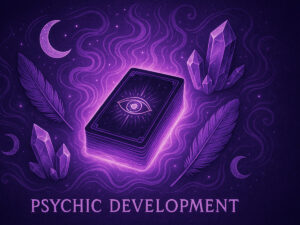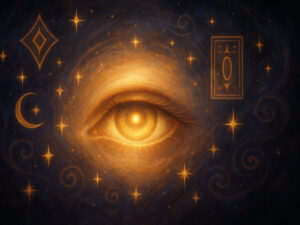How to Unlock Your Inner Wisdom Using Tarot


Table of Contents
Have you ever felt that slight panic when you pull a tarot card, frantically trying to remember its specific keyword meaning? You flip through the little white book, search online, maybe even consult your flashcards, hoping the answer magically clicks. I’ve totally been there! When I first started with tarot, it felt like trying to memorize a whole new language overnight. Seventy-eight cards, upright and reversed meanings… it was overwhelming, to say the least. It almost took the magic out of it for me. But what if there was another way? A way to connect with the cards that felt less like a school exam and more like a conversation with your own inner wisdom? That’s where intuitive tarot reading comes in, and honestly, it changed everything for my practice.
So, what is this magical-sounding intuitive reading? In simple terms, it’s about letting your gut feelings, the imagery on the cards, and your personal resonance guide your interpretation, rather than relying solely on memorized meanings. It’s about trusting that little voice inside you, the one that often knows more than you think. This post is your friendly guide to understanding what intuitive tarot reading is all about, why you might want to give it a try (especially if you’re feeling stuck!), and how you can start tapping into this amazing skill yourself. We’ll explore what makes it different, the benefits, some simple steps to get started, and tips to sharpen those intuitive senses. Ready to unlock a deeper connection with your cards? Let’s dive in.
What Exactly is Intuitive Tarot Reading?
Okay, so we’ve established that intuitive tarot reading isn’t about having a photographic memory for keywords. But what is it, really? Think of it as moving beyond just the ‘textbook’ definition of a card. It’s about diving deeper, using your immediate feelings, the specific images that jump out at you from the card, and the personal insights that bubble up when you look at it.
Instead of asking, “What does the book say this card means?”, you ask, “What does this card mean to ME, right now?”
Now, this doesn’t mean throwing out all traditional knowledge. Many tarot readers learn the ‘standard’ meanings, often rooted in systems like the Golden Dawn, numerology, or astrology. These systems provide a fantastic framework and a rich history. But intuitive reading prioritizes your personal connection and immediate response above strict adherence to those systems. It’s less about recalling a definition and more about experiencing the card.
It’s also important to bust a common myth: it’s rarely a case of being purely traditional or purely intuitive. As Carrie Mallon points out in her writing, this is often a false dichotomy. Most experienced readers naturally weave both approaches together. They might know the traditional meaning of the Six of Swords relates to transition, but their intuition, sparked by the specific imagery in their deck, might bring up feelings of sadness related to a past departure, adding a deeply personal layer to the reading. Even the ‘traditional’ meanings we use today originated from someone’s intuition way back when!
The artwork and symbolism on the cards are huge triggers for intuition. A specific color, the expression on a figure’s face, a tiny detail in the background – any of these can spark a feeling or an insight that goes beyond the basic keyword. Where does this intuition come from? It’s that blend of your inner wisdom, your subconscious making connections based on your life experiences, and sometimes, just that unexplainable gut feeling. It’s about trusting that you have an innate ability to understand the cards on a deeper level.
Why Try Intuitive Tarot Reading?
So, maybe you’re thinking, “Okay, I get what it is, but why should I ditch the book? Memorizing eventually works, right?” And sure, it can. But embracing intuitive reading offers some really lovely benefits that go beyond just knowing the keywords. If you’ve ever felt overwhelmed or disconnected during your tarot journey, this approach might just be the key.
First off, it’s a fantastic way to overcome that initial overwhelm. Let’s be real, facing 78 cards with complex meanings can feel like climbing a mountain. Intuitive reading gives you permission to start connecting right away, using the tools you already possess – your senses and feelings. It makes tarot feel more accessible, less like a daunting academic subject.
Beyond just making it easier, it fosters a much deeper personal connection with your cards and, importantly, with yourself. When you rely on your intuition, you’re not just interpreting a card; you’re engaging in a dialogue with your inner wisdom. Your deck becomes less of a tool and more of a companion on your journey of self-discovery.
This personal connection often leads to more meaningful and relevant insights. A standard keyword might give you a general idea, but your intuition can pinpoint exactly how that card’s energy applies to your specific situation, your feelings, your life. The messages feel less generic and more tailor-made, hitting closer to home.
Honestly? It also just makes the whole process more enjoyable and less stressful. Remember that feeling of panic I mentioned? Intuitive reading replaces that pressure with curiosity and playfulness. It becomes an exploration rather than a test. When you trust yourself, tarot feels less like work and more like magic.
And finally, perhaps the most empowering benefit is that it builds trust in yourself. Every time you tap into your intuition and find resonance in a reading, you reinforce the belief in your own inner knowing. It’s a powerful way to reclaim your confidence and recognize the wisdom you already hold within.
Simple Steps to Read Tarot Intuitively
Alright, ready to give it a go? It might sound mystical, but starting with intuitive reading is actually quite straightforward. It’s more about shifting your focus than learning complex techniques. Here’s a simple process you can follow, inspired by guides like those from Biddy Tarot and Liminal 11:
- Step 1: Set the Scene & Connect First things first, create a little space for yourself. Find somewhere quiet where you won’t be interrupted. Take a few deep breaths to calm your mind and let go of the day’s chatter. Clearly state your question or the intention for your reading, either out loud or in your head. And now for the crucial part, especially if you’re used to relying on it: gently put the guidebook aside. Just for now. Promise yourself you’ll rely on your own senses first.
- Step 2: Observe the Card Visually Draw a card. Now, just look at it. Don’t try to name it or recall its meaning yet. Let your eyes wander over the image. What’s the very first thing that catches your attention? Is it a specific color, a figure’s posture, an object, maybe something in the background? Spend 20-30 seconds just gazing, absorbing the visual details without judgment. You might want to jot down these initial visual impressions.
- Step 3: Feel the Card’s Energy As you look at the card, shift your attention to your feelings. How does the image make you feel? Happy, hopeful, anxious, sad, confused, empowered? Is the energy light or heavy? Notice any gut reactions or physical sensations that arise. This is your intuition speaking! Trust these feelings. As Brigit Esselmont from Biddy Tarot emphasizes, even if your feeling seems to contradict the ‘traditional’ meaning you might know, your intuition wins in this moment. That feeling holds a personal truth for you.
- Step 4: Tell the Card’s Story Now, engage your imagination. Look at the scene on the card and describe what’s happening as if you’re telling a story. Who are the characters (if any)? What are they doing, thinking, or feeling? What’s the overall atmosphere? What objects are present, and why might they be there? What could have happened just before this scene, and what might happen next? Telling the story out loud or writing it down can be really helpful to unlock the narrative.
- Step 5: Relate and Interpret Finally, bring it all together. How does the story you just told, the feelings you experienced, and the visual details you observed relate back to your original question or situation? Connect the dots. How does the card’s message, as revealed through your intuition, apply to your life right now? Synthesize these personal insights into an answer or guidance. This is where the intuitive magic happens, translating the card’s energy into relevant wisdom for you.
That’s the basic flow! It might feel a bit slow at first, but with practice, this process becomes much quicker and more natural, often happening in just a few moments.
Honing Your Intuitive Skills
Like any skill, reading tarot intuitively gets stronger and clearer the more you practice. It’s like flexing a muscle! While the steps above give you a great starting point, here are a few tips to help you really hone those intuitive senses and build confidence in your readings:
- Practice Consistently: This is the big one! Try to pull a card for yourself daily, even if it’s just one card. Use the intuitive steps. The more frequently you engage with your intuition in this way, the more readily it will speak up, and the easier it will become to understand its language.
- Keep a Tarot Journal: Seriously, this is a game-changer. Get a dedicated notebook and jot down your readings. Note the question, the card(s) pulled, your initial visual impressions, the feelings that came up, the story you saw, and your final interpretation. Importantly, revisit your journal entries later. Did the intuitive insight resonate? Did things unfold as the reading suggested? Tracking your experiences helps you recognize patterns in how your intuition communicates and builds trust in its accuracy.
- Trust Your Gut (Learn to Listen): This sounds simple, but it takes practice. Often, our logical brain wants to jump in and rationalize or dismiss those initial intuitive hits. Make a conscious effort to give weight to your very first impression or feeling about a card. Learn to differentiate that quiet nudge of intuition from louder voices like wishful thinking or fear. Intuition often feels calm and knowing, even if the message itself is challenging.
- Study Symbolism (If You Want!): While intuitive reading prioritizes personal response, learning about traditional tarot symbolism, archetypes, numerology, or astrology can actually enrich your intuition rather than stifle it. Think of it as expanding your intuitive vocabulary. Knowing the common meaning of a symbol (like a snake representing transformation) can add another layer to the personal feelings or story that symbol evokes for you. Just remember to let your intuition have the final say.
- Work with Different Decks: Don’t be afraid to explore! Different tarot decks have unique artwork, energy, and symbolism. You might find that one deck speaks to your intuition much more clearly than another. Playing with various decks can highlight different facets of your intuitive style and keep your practice fresh and engaging.
- A Note on Ethics: As you develop your intuitive skills, it’s important to use them responsibly. True intuition aims to empower and offer clarity. Be mindful of the difference between genuine intuitive insight and simply making things up or projecting your own biases. Some discussions online highlight concerns about “manipulative” readings disguised as intuitive ones (like guaranteeing a soulmate from a Tower card). Ethical intuitive reading is grounded in respect for the querent (even if it’s yourself) and the tarot, aiming for helpful guidance, not false promises or fear-mongering.
Trust Your Inner Tarot Reader
So there you have it – a peek into the wonderful world of intuitive tarot reading! It’s not about abandoning structure entirely, but about adding a deeply personal, resonant layer to your practice. It’s about recognizing that the magic of tarot isn’t just in the cards themselves, but in the connection you forge with them and with your own profound inner wisdom. Moving beyond rote memorization can unlock a more meaningful, enjoyable, and insightful relationship with your deck.
Remember, the key benefits are truly transformative: overcoming that initial overwhelm, fostering a unique connection with your cards, gaining insights that feel personally tailored, and, most importantly, building unshakeable trust in your own intuition. It’s an empowering path that makes tarot less of a study session and more of an intimate conversation.
Don’t be afraid to experiment! Put the book down, gaze at the cards, feel their energy, and listen to the stories they whisper just for you. Your intuition is a powerful guide, waiting to be acknowledged. Trust it. Play with it. See where it leads you.
Now, I’d love to hear from you! Have you tried reading tarot intuitively? What are your favorite techniques or experiences? Or if you’re new to this, are you inspired to give it a try? Share your thoughts and experiences in the comments below – let’s learn from each other!
Frequently Asked Questions
Here are answers to some common questions about intuitive tarot reading:
What’s the main difference between intuitive and traditional tarot reading again?
Traditional reading often relies more heavily on established systems, keywords, and memorized meanings associated with each card (like those from specific schools of thought like the Golden Dawn). Intuitive reading prioritizes your personal, immediate response to the card – the feelings, images, and insights that arise for you in the moment, using the traditional meanings more as a flexible framework than a rigid rulebook.
Do I need to be psychic to read tarot intuitively?
Not at all! While some people might blend psychic abilities with tarot, intuitive reading as discussed here is about tapping into your own inner wisdom, subconscious connections, and gut feelings. Everyone has intuition; it’s a natural human ability that you can develop with practice, like strengthening a muscle.
Can beginners learn intuitive tarot reading?
Absolutely! In fact, many beginners find it less overwhelming than trying to memorize everything upfront. It allows you to start connecting with the cards immediately using your own perceptions and feelings. You can always learn traditional meanings alongside developing your intuition.
So, should I ignore the traditional card meanings completely?
Not necessarily! Learning traditional meanings and symbolism can actually enrich your intuitive readings. Think of it like learning vocabulary for a language – it gives your intuition more to work with. The key is not to let the book meanings override your gut feeling but to see how they might complement or deepen your personal insight.
How do I know if it’s my intuition or just my imagination making things up?
This is a common question and takes practice to discern! Intuition often feels like a quiet knowing, a gut feeling, or an insight that arrives calmly, even if the message is difficult. Imagination or wishful thinking might feel more forced, emotionally charged (especially with fear or strong desire), or like you’re consciously constructing a story. Keeping a tarot journal (as mentioned in the post) can help you track your intuitive hits and misses and learn the unique ‘feel’ of your own intuition.
What kinds of questions work best for intuitive readings?
Intuitive readings excel with open-ended questions focused on guidance, self-understanding, exploring options, or understanding underlying dynamics. Questions like “What do I need to understand about this situation?”, “What energy should I focus on right now?”, or “What might be blocking me?” often yield richer intuitive insights than very specific yes/no or predictive questions.
Is intuitive reading less accurate?
Accuracy in tarot is subjective. Intuitive reading aims for personal relevance and insightful guidance rather than strict factual prediction. Its ‘accuracy’ lies in how deeply the message resonates with you and provides helpful clarity for your situation. For many, this personal resonance makes it feel more accurate and meaningful than a generic interpretation.
Can intuitive tarot predict the future?
Most modern tarot readers, intuitive or otherwise, view tarot less as a fortune-telling tool for fixed futures and more as a guide to explore possibilities, understand current energies, and make empowered choices. An intuitive reading might show potential outcomes based on the current path, but the future is generally seen as fluid and influenced by your actions.






